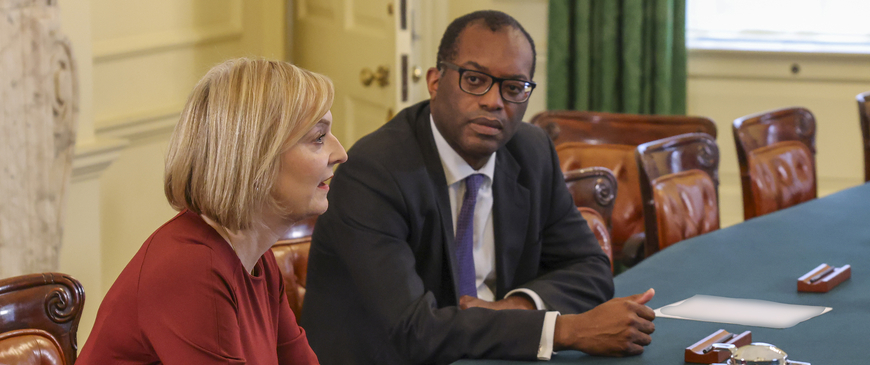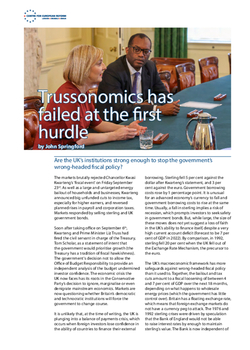
Trussonomics has failed at the first hurdle
Are the UK’s institutions strong enough to stop the government’s wrong-headed fiscal policy?
The markets brutally rejected Chancellor Kwasi Kwarteng’s 'fiscal event' on Friday September 23rd. As well as a large and untargeted energy bailout of households and businesses, Kwarteng announced big unfunded cuts to income tax, especially for higher earners, and reversed planned rises in payroll and corporation taxes. Markets responded by selling sterling and UK government bonds.
Soon after taking office on September 6th, Kwarteng and Prime Minister Liz Truss had fired the civil servant in charge of the Treasury, Tom Scholar, as a statement of intent that the government would prioritise growth (the Treasury has a tradition of fiscal hawkishness). The government's decision not to allow the Office of Budget Responsibility to provide an independent analysis of the budget undermined investor confidence. The economic crisis the UK now faces has its roots in the Conservative Party’s decision to ignore, marginalise or even denigrate mainstream economics. Markets are now questioning whether Britain’s democratic and technocratic institutions will force the government to change course.
It is unlikely that, at the time of writing, the UK is plunging into a balance of payments crisis, which occurs when foreign investors lose confidence in the ability of countries to finance their external borrowing. Sterling fell 5 per cent against the dollar after Kwarteng’s statement, and 3 per cent against the euro. Government borrowing costs rose by 1 percentage point. It is unusual for an advanced economy’s currency to fall and government borrowing costs to rise at the same time. Usually, a fall in sterling implies a risk of recession, which prompts investors to seek safety in government bonds. But, while large, the size of these moves does not yet suggest a loss of faith in the UK’s ability to finance itself, despite a very high current account deficit (forecast to be 7 per cent of GDP in 2022). By comparison, in 1992, sterling fell 20 per cent when the UK fell out of the Exchange Rate Mechanism, the precursor to the euro.
The UK’s macroeconomic framework has more safeguards against wrong-headed fiscal policy than it used to. Together, the bailout and tax cuts amount to a fiscal loosening of between 4 and 7 per cent of GDP over the next 18 months, depending on what happens to wholesale energy prices (which the government has little control over). Britain has a floating exchange rate, which means that foreign exchange markets do not have a currency peg to attack. The 1976 and 1992 sterling crises were driven by speculation that the Bank of England would not be able to raise interest rates by enough to maintain sterling’s value. The Bank is now independent of government, with an inflation target rather than the electoral cycle driving policy. Indeed, markets predict that the Bank of England’s base rate will peak at over 6 per cent.
A full-blown UK financial crisis is unlikely, but if Truss doesn’t u-turn on her unfunded tax cuts, it will be hard to avoid a recession.
However, the leap in borrowing costs after Kwarteng’s statement will be extremely painful, leading to much higher mortgage payments and lower business investment. Many households have short-term, fixed-rate mortgages that will have to be refinanced in the next two years. If mortgage interest rates rise from around 2 per cent to over 6 per cent, households face huge cuts in discretionary spending of hundreds of pounds per month. That is after their energy costs have doubled, and prices for other goods and services have risen rapidly too. Businesses will also find it more expensive to fund their investments. So, by making the Bank raise rates, Truss and Kwarteng’s policies will lower growth substantially.
And, without clear signals from the government, Parliament, the Bank of England and the media that the public finances will be put on a sustainable footing, a balance of payments crisis will become more likely. Kwarteng plans a full budget in November and could announce tax rises and public spending cuts to reassure investors. Unless he clearly signals he will do that, Conservative MPs could threaten to vote against his tax cuts, forcing him to change course. Truss could reaffirm her commitment to the independence of the Bank of England, which could hold an emergency meeting and vote to tighten monetary policy further. The Bank was forced to buy long-dated government bonds on September 28th, in order to shore up pension funds, but it will have to raise rates at its next meeting. The reaction of the British media, which has become much more partisan since the Brexit vote, will be an important gauge for investors of whether the UK political system is continuing down the path to US-style polarisation, with a right-wing press that at best questions the patriotism and good faith of the government’s critics and at worst demonises them.
The Bank of England and Parliament can put the brakes on Truss’s unsustainable fiscal policy. The question is whether they will do so.
However, the degree of ideological fervour on the right means that the solutions to the UK’s economic problems are unlikely to come from the Conservatives. Brexit has reduced the supply capacity of the British economy, with imports, investment and immigration all being curtailed. The energy price shock has further reduced supply, by raising businesses’ costs; and demand, by forcing households to reduce discretionary spending. Public services are underfunded and struggling to recruit staff. Tax cuts and higher interest rates will do little to solve those problems. There is little reason to believe that tax cuts for the wealthy or lower corporate taxation will sustainably raise growth: the UK has combined low taxes with weak investment and productivity, compared with other advanced economies, for several decades. Interest rates balance savings and investment, and with growth prospects looking weak thanks to Brexit and the energy price shock, higher rates will lead households and businesses to save rather than prompting them to invest more.
Britain needs a plausible programme for macroeconomic stability and higher investment. As well as commitments to keep debt sustainable and to safeguard the central bank’s independence, the government could further loosen immigration rules, in order to offset the loss of workers to ill-health, retirement and to EU countries after the end of free moment. Truss hopes to do this, but according to reports, she is facing opposition from her cabinet. The government could announce a strategy of energy efficiency subsidies and licensing for renewables that would quickly reduce Britain’s dependence on imported fossil fuels – Kwarteng has overturned the absurd ban on onshore wind, to his credit. The government could make sizeable investments in transport and education, to raise workers’ skills and make it easier for them to commute to better-paying jobs. It could increase health spending to help people in ill-health to return to work. The UK could end the threat of a trade war with the EU by finding a compromise on the Northern Ireland Protocol. It could lay out principles for alignment and divergence from EU rules, promising only to change EU regulations if civil service analysis shows that the benefits of divergence outweigh its costs.
But many of these policies are diametrically opposed to the reigning ideology in Truss’s government. Overall, they would require fiscal policy to be reoriented towards investment and tax rises. With two years to go until a general election is likely to be held, Truss and Kwarteng will be tempted to dig in and hope that falling energy prices come to their rescue. This is a big gamble – and it is up to Parliament, the Bank of England and the media to press them to change course before markets force them to do so.
John Springford is deputy director of the Centre for European Reform.

